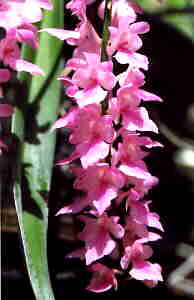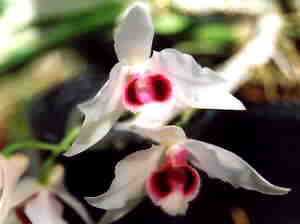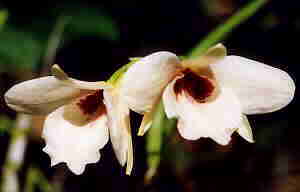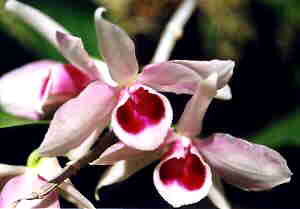NewsletterTemplate
BP SPECIES
NEWSLETTER September 2002
July
00
Aug
Sept
Oct
Nov
Dec
Jan01
Feb
Mar
April
May
June
July
Aug
Sept
Oct
Nov
Dec
Jan02
Feb
March
April
May
June
July
Aug
Culture.
Deciduous Dendrobiums
WHATS NEW ?
IMPORTANT NOTE
click here for USA importers.
Phytos & Permits.
In FLASK.
Aerangis distincta, Aerangis splendida, Aerides fieldingii (photo right),
Aerides maculosum.

In PLANTS.
Bulbophyllum Baileyii.
Ready
to replate.
Aerangis
biloba Eurychone galeandrae, Paph praestans x primulinum.
Culture.
Deciduous Dendrobiums
Did you
know?
Worldwide exchange of seed and protocorm.
Permits
USA.
Web Site.
www.speciesorchids.com New Links plus more photographs up.
Orchid Auction.
Plants, Flasks, Books.
Flasking
supplies,
medias,
nonabsorb cotton wool
.
Notes on
flasking.
Seed
for sale
.
Email
now for a list of available species orchid seed.
Spare Flasks
on hand.
Some species that
can be shipped NOW.
Humour.
Subscribe,
Unsubscribe.
Request. click here for
Flask
List
Plant
List
New
Germinations
Photos in this issue
. Above
Aerides fieldingii, Dend rhodopterygium semialba,Dend albosanguineum,
Dend anosum var Huttonii.
Items in this Newsletter may be reproduced
provided source acknowledged. Do you know any orchid growers who may like
to receive this newsletter? Why not forward this email to them now!
A b&w printed copy of this Newsletter can be
mailed each month if you send 12 Australian stamps or 12 International
reply coupons to Burleigh Park Orchid Nursery, 54 Hammond Way, Thuringowa,
Australia 4815.
We commend "Orchids Online
Web Design" for the excellent work on our web site.
For information or prices
click
here
or email Steve at steve@orchidsonline.com........
Steve is looking for Orchid
Society and Orchid Nursery Information to include on his site.
If you can help, why not
visit his website at
http://www.orchidsonline.com.au
and fill in
the online form now
New
in Flask.
Two small growing
Angraecoids
,
Aerangis distincta
and
A. splendida
, are shade growers that require excellent
air movement. Basically they require a well drained mount, a piece of treefern
or a very small open pot with a well drained media.
Both produce spikes of white spurred flowers that are fragrant
at night. Rather elegant species that should be grown protected from extremes,
they do not like to be very cold and very high temperatures will cause
growing problems.
Aerides fieldingii
is a showy species originally
from India. It is now difficult to obtain Indian species due to the
export restrictions of that country. It is a robust plant that does
best in a basket in a well drained media, and will grow happily under
the same conditions as Dendrobiums etc., with perhaps a little more shade
in the hotter months.
Spikes are long and many flowered, the crystalline pink flowers
usually have a darker amethyst labellum and are fragrant.
Aerides maculosum
also from India, is a similar
flowered species to
A. fieldingii
, but the plant is much smaller
with narrower leaves. It grows readily in a basket and will eventually
produce side shoots. The flowers are also crystalline pink on long spikes.
The two species flower at different times and are well worth cultivation
for the fragrant crystalline flowers.
Top
New
in Plants
.
Bulbophyllum Baileyii
,
the Australian native
species, grows extremely well in a well drained basket or on a large slab
of treefern. The plant consists of a series of smallish pseudobulbs on
a creeping rhizome, each with a large oval leaf. Thus a large shallow container
or slab is best to allow the plant to climb over and around to form a specimen.
The fragrant flowers are pale yellow, finely spotted with red,
with a hinged mobile labellum and in Australia seem to attract a small
yellow wasp. The flowers are produced along the rhizome.
It is a tropical species and requires warmth and light, to almost
full sunlight, and when in active growth, lots of water.
Top
Ready
to Replate.
Aerangis biloba
,
the
African species, does best on a mount of shallow container. The fragrant
flowers are produced on a long semi pendulous spike and have a long spur.
Growing conditions as for
Aerangis
listed above.
Eurychone galeandrae
is
small African Angraecoid species that looks somewhat like a small
Phalaenopsis
plant. It is grown the same way as the
Aerangis
species.
The flowers are quite distinctive, with
a quite large almost trumpet like labellum with a short wide spur. This
particular species
is green white with tan brown colouring in
the labellum, and the flower indeed does look much like the flower of the
genus
Galeandra,
particularly
G. bauerii.
Paphiopedilum praestans x primulinum.
A yellow and red Paph jogjae??
Paphiopedilum
praestans
is yellow with red stripes
and
P.
primulinum
is all over yellow.
At one time, the major exporter of
Paphs
from Indonesia was exporting what he described as a new species called
Paph jogjae.
Then it became known as the natural hybrid
Paphiopedilum
praestans x Paphiopedilum glaucophyllum
.
With further investigation, it appears to
have been a garden hybrid widely cultivated in the Dutch colony, subsequently
obtained by the exporter and " introduced" to the orchid world.
As one of the importers of that original
Paph jogjae
, it is with curiosity that we mated the two yellow species,
the P.
primulinum
very much a yellow
glaucophyllum.
These are easy to grow
Paphs
.,
well drained media in a large pot with sunlight and conditions used for
Dendrobiums
seems to work well. They are the warmer growing slippers
and will tolerate a wide range of climate conditions and in warmer climates
can be used as a garden plant.
More photos at
www.speciesorchids.com/photos.html
Top
Culture.
Deciduous Dendrobiums.
It is Spring in Australia, "down under", and time to repot
the spring flowering
Dendrobiums
that have been held dry and dormant
over winter.
Slotted pots or baskets are used, with a mixture of bark and shredded
isolite for some species, and for those that like a little extra moisture,
a mix of spaghnam moss and isolite. The larger more robust growers benefit
from a richer media.
Species such as;
Dendrobium primulinum
;
flowers pink to pink purple
with a finely downy yellow trumpet like labellum.This species comes from
India, has more or less pendulous canes and is potted in the bark mix.
Fragrant, spring flowering.
 Dendrobium rhodopterygium
and its very close relative
Dend parishii
; flowers dark purple magenta, the tubular lip
with two dark eyes. Highly fragrant, the short thick canes tend to be erect
until the weight of longer canes causes them to arch over.
There semi alba form of both, white with the purple coloured labellum.
A bark mix is used, although the larger growing
D rhodopterygium
may
appreciate the spaghnum and extra moisture.
D. rhodopterygium
comes
from India while the
D. parishii
is distributed from India thru
to Thailand.
Dendrobium rhodopterygium
and its very close relative
Dend parishii
; flowers dark purple magenta, the tubular lip
with two dark eyes. Highly fragrant, the short thick canes tend to be erect
until the weight of longer canes causes them to arch over.
There semi alba form of both, white with the purple coloured labellum.
A bark mix is used, although the larger growing
D rhodopterygium
may
appreciate the spaghnum and extra moisture.
D. rhodopterygium
comes
from India while the
D. parishii
is distributed from India thru
to Thailand.
 Dendrobium albosanguineum
, (photo left) from Burma,
has large pale yellow flowers with two dark maroon blotches in the labellum,
which is also veined with red. An erect plant with quite heavy robust canes
when grown in maximum sunlight to the extent of leaf burn.
Dendrobium anosum, aka Dendrobium superbum
, is a
very robust growing species that will take a large pot or basket
Dendrobium albosanguineum
, (photo left) from Burma,
has large pale yellow flowers with two dark maroon blotches in the labellum,
which is also veined with red. An erect plant with quite heavy robust canes
when grown in maximum sunlight to the extent of leaf burn.
Dendrobium anosum, aka Dendrobium superbum
, is a
very robust growing species that will take a large pot or basket
 and a rich media that provides moisture without remaining soggy. It will
produce canes to several feet long and large quantities of large purple
flowers at the nodes. Highly fragrant of raspberry, with opinions differing
on actual flavour and desirability of the fragrance, it is somewhat
overpowering.
The species ranges from India to the Philippines and New Guinea.
There is an alba form
var dearei
, and a semialba form
var Huttoni ( photo right)
The species is well worth growing and makes a spectacular specimen,
with either all purple flowers, all white or the semialba white and purple.
Dendrobium aphyllum, aka Dendrobium pierardii.
This species also ranges from India thru to South East Asia, and there
are a number of different forms in both plant growth and flower colouring.
Typically a pendulous plant, with thin canes that in at least one
form, will reach 6 feet in length, and flowers produced in pairs
at almost all the stem nodes. A large basket seems to be best, especially
as the canes often produce aerial plantlets that can be tied back
to the basket to produce a dense specimen clump.
Flowers are generally pale pink to green pink, the labellum pale
green to cream or pale yellow, fragrant.
These deciduous species are allowed to dry out completely during
July and August ( winter, southern hemisphere), without much normal rainfall,
and are repotted when the new lead appears. With the repot, lots of water
and fertiliser will promote large new canes, the bearers of the next seasons
flowering.
Species highlighted are links to more details.
More photos at
www.speciesorchids.com/photos.html
Top
Did
you know ?
Burleigh Park has a worldwide exchange program of orchid seed
and sterile tubes of protocorm. If you would like to exchange seed or protocorm,
email Ian
click
here
and lists will be emailed to you.
Do you set seed pods on your
treasured species orchids? The best conservation, sow seed, you will then
know where to find them again.
IMPORTANT NOTE for USA importers.
USDA has, from January 2002, begun to enforce the requirement for
a
Phytosanitary Certificate
for all plant and plant material imports.
This is not a new regulation, but the implementation of a rule that has
previously not been enforced.
ALL FLASKS
imported into USA will now require a
Phytosanitary
Certificate
.
Burleigh Park does provide this Phytosanitary Certificate at cost.
Flasks are still CITES exempt.
Click
here
for the full details previously published.
Phytosanitary Certificate requirements for all countries.
We are preparing a data base for the import requirements for Phytosanitary
Certificates for as many countries as possible.
If you have permits or other information, please contact us so
that we can include as many countries as possible. A snailmail photo copy
would be ideal.
The data base will list the various requirements to import flasks
and orchid plants into each country and any special requirements pertaining
to Phytosanitary Certificates.
We all dislike red tape, but the Certificates and Permits
mean disease and pest free imports and quicker delivery to you.
Do you set seed pods on your
treasured species orchids? The best conservation, sow seed.
Top
Web
site
.
More Photographs Up
Check out our web
page
www.speciesorchids.com
Year
2000 winner of "Linda the Orchid Lady" award .
EMAIL address
Top
Auction.
ORCHID AUCTION ACTION
Have a look at this busy Orchid Auction site.
PLANTS BOOKS FLASKS
Sell those spare plants ! Find that elusive
rare plant or book !
Orchid
Auction Site
Top
Flask
supplies.
Flasking medias; click
on here and go to Supplies page
www.speciesorchids.com
For working Nursery Medias for Mother and Replate Flasks.
A special note on flasking
orchids.
Due to the need for a
filtered air vent
on flasks to allow
exchange of gasses,
a reliable air filter medium is needed
.
Non absorbant cotton wool
allows gas exchange but does not
absorb moisture. Thus the air filter will stay dry and prevent the growth
of fungus thru the filter, a common problem with ordinary cotton wool which
gets wet, goes mouldy and allows the mould to grow thru the filter to
contaminate
the flask.
Non Absorbant Cottonwool NOW AVAILABLE in
375 gram rolls,
click
contact
us NOW
.
Top
Seed
of SPECIES orchids
.
Email
Cal
for the latest list of seed available in packets enough
to prepare 3 to 4 flasks.
Coryanthes, Dendrobium, Paphiopedilum, Oncidium, Cattleya, Aerides
with more added as harvested.
All seed dated at collection, airmail post world wide and there
is no restriction on orchid seed.
Cal's Orchids Australia.
CONSERVATION BY PROPAGATION
.
Spare
Flasks on hand.
There are sometimes spare flasks available. These are ready
to ship, but we do not recommend shipping these flasks in y
our winter
as they are ready to deflask now.
For a list of available flasks,
email
or
click
here
Top
Humour.
and a rich media that provides moisture without remaining soggy. It will
produce canes to several feet long and large quantities of large purple
flowers at the nodes. Highly fragrant of raspberry, with opinions differing
on actual flavour and desirability of the fragrance, it is somewhat
overpowering.
The species ranges from India to the Philippines and New Guinea.
There is an alba form
var dearei
, and a semialba form
var Huttoni ( photo right)
The species is well worth growing and makes a spectacular specimen,
with either all purple flowers, all white or the semialba white and purple.
Dendrobium aphyllum, aka Dendrobium pierardii.
This species also ranges from India thru to South East Asia, and there
are a number of different forms in both plant growth and flower colouring.
Typically a pendulous plant, with thin canes that in at least one
form, will reach 6 feet in length, and flowers produced in pairs
at almost all the stem nodes. A large basket seems to be best, especially
as the canes often produce aerial plantlets that can be tied back
to the basket to produce a dense specimen clump.
Flowers are generally pale pink to green pink, the labellum pale
green to cream or pale yellow, fragrant.
These deciduous species are allowed to dry out completely during
July and August ( winter, southern hemisphere), without much normal rainfall,
and are repotted when the new lead appears. With the repot, lots of water
and fertiliser will promote large new canes, the bearers of the next seasons
flowering.
Species highlighted are links to more details.
More photos at
www.speciesorchids.com/photos.html
Top
Did
you know ?
Burleigh Park has a worldwide exchange program of orchid seed
and sterile tubes of protocorm. If you would like to exchange seed or protocorm,
email Ian
click
here
and lists will be emailed to you.
Do you set seed pods on your
treasured species orchids? The best conservation, sow seed, you will then
know where to find them again.
IMPORTANT NOTE for USA importers.
USDA has, from January 2002, begun to enforce the requirement for
a
Phytosanitary Certificate
for all plant and plant material imports.
This is not a new regulation, but the implementation of a rule that has
previously not been enforced.
ALL FLASKS
imported into USA will now require a
Phytosanitary
Certificate
.
Burleigh Park does provide this Phytosanitary Certificate at cost.
Flasks are still CITES exempt.
Click
here
for the full details previously published.
Phytosanitary Certificate requirements for all countries.
We are preparing a data base for the import requirements for Phytosanitary
Certificates for as many countries as possible.
If you have permits or other information, please contact us so
that we can include as many countries as possible. A snailmail photo copy
would be ideal.
The data base will list the various requirements to import flasks
and orchid plants into each country and any special requirements pertaining
to Phytosanitary Certificates.
We all dislike red tape, but the Certificates and Permits
mean disease and pest free imports and quicker delivery to you.
Do you set seed pods on your
treasured species orchids? The best conservation, sow seed.
Top
Web
site
.
More Photographs Up
Check out our web
page
www.speciesorchids.com
Year
2000 winner of "Linda the Orchid Lady" award .
EMAIL address
Top
Auction.
ORCHID AUCTION ACTION
Have a look at this busy Orchid Auction site.
PLANTS BOOKS FLASKS
Sell those spare plants ! Find that elusive
rare plant or book !
Orchid
Auction Site
Top
Flask
supplies.
Flasking medias; click
on here and go to Supplies page
www.speciesorchids.com
For working Nursery Medias for Mother and Replate Flasks.
A special note on flasking
orchids.
Due to the need for a
filtered air vent
on flasks to allow
exchange of gasses,
a reliable air filter medium is needed
.
Non absorbant cotton wool
allows gas exchange but does not
absorb moisture. Thus the air filter will stay dry and prevent the growth
of fungus thru the filter, a common problem with ordinary cotton wool which
gets wet, goes mouldy and allows the mould to grow thru the filter to
contaminate
the flask.
Non Absorbant Cottonwool NOW AVAILABLE in
375 gram rolls,
click
contact
us NOW
.
Top
Seed
of SPECIES orchids
.
Email
Cal
for the latest list of seed available in packets enough
to prepare 3 to 4 flasks.
Coryanthes, Dendrobium, Paphiopedilum, Oncidium, Cattleya, Aerides
with more added as harvested.
All seed dated at collection, airmail post world wide and there
is no restriction on orchid seed.
Cal's Orchids Australia.
CONSERVATION BY PROPAGATION
.
Spare
Flasks on hand.
There are sometimes spare flasks available. These are ready
to ship, but we do not recommend shipping these flasks in y
our winter
as they are ready to deflask now.
For a list of available flasks,
email
or
click
here
Top
Humour.
She: Would you get married again?
He: Definitely not!
She: Why not - don't you like being married?
He: Of course I do.
She: Then why wouldn't you remarry?
He: Okay, I'd get married again.
She: You would? (with a hurtful look on her face)
He: ( makes audible groan )
She: Would you sleep with her in our bed?
He: Where else would we sleep?
She: Would you put away my pictures, and replace
them with pictures of her?
He: That would seem like the proper thing to do.
She: And would you let her use my golf clubs?
He: She can't use them; she's left-handed...
She: - - - silence - - -
One afternoon, a wealthy lawyer was riding in the back
of his limousine when he saw two men eating grass by the road side. He
ordered his driver to stop and he got out to investigate.
"Why are you eating grass?" He asked one man.
"We don't have any money for food" the poor man replied.
"Oh, well, you can come with me to my house" instructed the lawyer.
"But, sir, I have a wife and two children with me!"
"Bring them along!" replied the lawyer.
He turned to the other man and said, "You come with us, too."
"But, sir, I have a wife and six children!" the second man answered.
"Bring them as well!" answered the lawyer as he headed for his limo.
They all climbed into the car, which was no easy task, even for
a car as large as the limousine.
Once underway, one of the poor fellows says: "Sir, you are too kind.
Thank you for taking all of us with you."
The lawyer replied,
"Glad to do it. You'll love my place; the grass is almost a foot
tall"
Top
Subscribe.
To have
your name
added
or
removed
from the mailing list, email
click
here
"Unsubscribe me please!"
or
click
here
Ian and Pat Walters,
Burleigh Park Orchid Nursery
54 Hammond Way, Thuringowa,
Australia 4815
Email us at
www.speciesorchids.com
Phone Fax 0747 740 008
International 61 747 740 008
For Web Design and Web Hosting
Contact Orchids Online Web Design
Designed by
Orchids
Online Web Design
© All rights reserved.
|



 and a rich media that provides moisture without remaining soggy. It will
produce canes to several feet long and large quantities of large purple
flowers at the nodes. Highly fragrant of raspberry, with opinions differing
on actual flavour and desirability of the fragrance, it is somewhat
overpowering.
The species ranges from India to the Philippines and New Guinea.
and a rich media that provides moisture without remaining soggy. It will
produce canes to several feet long and large quantities of large purple
flowers at the nodes. Highly fragrant of raspberry, with opinions differing
on actual flavour and desirability of the fragrance, it is somewhat
overpowering.
The species ranges from India to the Philippines and New Guinea.
